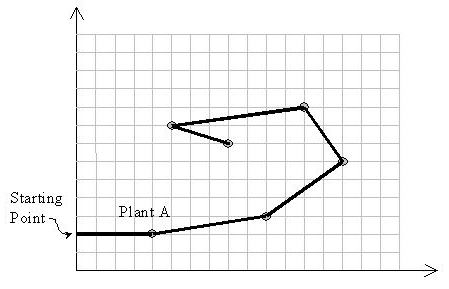poj 1696 叉积理解
| Time Limit: 1000MS | Memory Limit: 10000K | |
| Total Submissions: 3967 | Accepted: 2489 |
Description
- It can not turn right due to its special body structure.
- It leaves a red path while walking.
- It hates to pass over a previously red colored path, and never does that.
The pictures transmitted by the Discovery space ship depicts that plants in the Y1999 grow in special points on the planet. Analysis of several thousands of the pictures have resulted in discovering a magic coordinate system governing the grow points of the plants. In this coordinate system with x and y axes, no two plants share the same x or y.
An M11 needs to eat exactly one plant in each day to stay alive. When it eats one plant, it remains there for the rest of the day with no move. Next day, it looks for another plant to go there and eat it. If it can not reach any other plant it dies by the end of the day. Notice that it can reach a plant in any distance.
The problem is to find a path for an M11 to let it live longest.
Input is a set of (x, y) coordinates of plants. Suppose A with the coordinates (xA, yA) is the plant with the least y-coordinate. M11 starts from point (0,yA) heading towards plant A. Notice that the solution path should not cross itself and all of the turns should be counter-clockwise. Also note that the solution may visit more than two plants located on a same straight line. 
Input
Output
Sample Input
2
10
1 4 5
2 9 8
3 5 9
4 1 7
5 3 2
6 6 3
7 10 10
8 8 1
9 2 4
10 7 6
14
1 6 11
2 11 9
3 8 7
4 12 8
5 9 20
6 3 2
7 1 6
8 2 13
9 15 1
10 14 17
11 13 19
12 5 18
13 7 3
14 10 16
Sample Output
10 8 7 3 4 9 5 6 2 1 10
14 9 10 11 5 12 8 7 6 13 4 14 1 3 2
/*
poj 1696 叉积理解 给你n个点,要求从一个点出发,每次只能 左or直走. 求路径
先找出最做下角的点,然后通过叉积排序判断出离当前点需要旋转最小角度可以到达的点
如果两个点在一条直线上面,则选取距离最近的 hhh-2016-05-06 20:40:31
*/
#include <iostream>
#include <vector>
#include <cstring>
#include <string>
#include <cstdio>
#include <queue>
#include <cmath>
#include <algorithm>
#include <functional>
#include <map>
using namespace std;
#define lson (i<<1)
#define rson ((i<<1)|1) using namespace std;
const int maxn = 40010;
double eps = 1e-8;
int tot;
int n,m; int sgn(double x)
{
if(fabs(x) < eps) return 0;
if(x < 0)
return -1;
else
return 1;
} struct Point
{
int id;
double x,y;
Point() {}
Point(double _x,double _y)
{
x = _x,y = _y;
}
Point operator -(const Point &b)const
{
return Point(x-b.x,y-b.y);
}
double operator ^(const Point &b)const
{
return x*b.y-y*b.x;
}
double operator *(const Point &b)const
{
return x*b.x + y*b.y;
}
}; struct Line
{
Point s,t;
Line() {}
Line(Point _s,Point _t)
{
s = _s;
t = _t;
}
pair<int,Point> operator &(const Line&b)const
{
Point res = s;
if( sgn((s-t) ^ (b.s-b.t)) == 0) //通过叉积判断
{
if( sgn((s-b.t) ^ (b.s-b.t)) == 0)
return make_pair(0,res);
else
return make_pair(1,res);
}
double ta = ((s-b.s)^(b.s-b.t))/((s-t)^(b.s-b.t));
res.x += (t.x-s.x)*ta;
res.y += (t.y-s.y)*ta;
return make_pair(2,res);
}
};
Point tp;
Point po[maxn]; double dist(Point a,Point b)
{
return sqrt((a-b)*(a-b));
} bool cmp(Point a,Point b)
{
double t = (a-tp)^(b-tp);
if(sgn(t) == 0)
{
return dist(a,tp) < dist(b,tp);
}
if(sgn(t) < 0)
return false;
else
return true;
} int main()
{
int n,T;
scanf("%d",&T);
while(T--)
{
scanf("%d", &n);
tp.x = 10000,tp.y = 10000;
for(int i = 0; i < n; i++)
{
scanf("%d%lf%lf",&po[i].id,&po[i].x,&po[i].y);
if(po[i].y < tp.y || (po[i].y == tp.y && po[i].x < tp.x))
{
tp = po[i];
}
} for(int i = 0; i < n; i++)
{
sort(po+i,po+n,cmp);
tp = po[i];
}
printf("%d ",n);
for(int i = 0; i < n; i++)
{
printf("%d%c",po[i].id, i == n-1 ? '\n':' ');
}
}
return 0;
}
poj 1696 叉积理解的更多相关文章
- poj 2318 叉积+二分
TOYS Time Limit: 2000MS Memory Limit: 65536K Total Submissions: 13262 Accepted: 6412 Description ...
- poj 1696 (计算几何基础)
poj 1696 Space Ant 链接:http://poj.org/problem?id=1696 题意:在坐标轴上,给定n个点的 id 以及点的坐标(xi, yi),让你以最底端点开始,从右依 ...
- poj 1696 Space Ant(模拟+叉积)
Space Ant Time Limit: 1000MS Memory Limit: 10000K Total Submissions: 3840 Accepted: 2397 Descrip ...
- POJ 1696 Space Ant 极角排序(叉积的应用)
题目大意:给出n个点的编号和坐标,按逆时针方向连接着n个点,按连接的先后顺序输出每个点的编号. 题目思路:Cross(a,b)表示a,b的叉积,若小于0:a在b的逆时针方向,若大于0a在b的顺时针方向 ...
- POJ 1696 - Space Ant 凸包的变形
Technorati Tags: POJ,计算几何,凸包 初学计算几何,引入polygon后的第一个挑战--凸包 此题可用凸包算法做,只要把压入凸包的点从原集合中排除即可,最终形成图形为螺旋线. 关于 ...
- 简单几何(凸包) POJ 1696 Space Ant
题目传送门 题意:一个蚂蚁一直往左边走,问最多能走多少步,且输出路径 分析:就是凸包的变形题,凸包性质,所有点都能走.从左下角开始走,不停排序.有点纠结,自己的凸包不能AC.待理解透凸包再来写.. 好 ...
- poj 1696 Space Ant (极角排序)
链接:http://poj.org/problem?id=1696 Space Ant Time Limit: 1000MS Memory Limit: 10000K Total Submissi ...
- 补充一下我对 POJ 3273 的理解,这肯定是我一生写的最多的题解。。。
题目:http://poj.org/problem?id=3273 当分成的组数越多,所有组的最大值就会越小或不变,这一点不难证明: 如果当前分成了group组,最大值是max,那么max的这一 ...
- POJ 1696 Space Ant(点积的应用)
Space Ant 大意:有一仅仅蚂蚁,每次都仅仅向当前方向的左边走,问蚂蚁走遍全部的点的顺序输出.開始的点是纵坐标最小的那个点,開始的方向是開始点的x轴正方向. 思路:从開始点開始,每次找剩下的点中 ...
随机推荐
- 【iOS】swift-通过JS获取webView的高度
let webHeightStr = webView.stringByEvaluatingJavaScriptFromString("document.body.scrollHeight& ...
- 个人技术博客(alpha)
APP的权限校验不同于web网页端,web一般使用session记录用户的状态信息,而app则使用token令牌来记录用户信息.有这样一个场景,系统的数据量达到千万级,需要几台服务器部署,当一个用户在 ...
- php抽象类和接口的区别
php抽象类和接口的区别 tags:抽象类 接口 抽象类和接口 php 引言:这是一个面试经常被问到的问题,也是一个经典问题.我们尽量引用官方权威的说明或者经过实验来证明本文所说的内容准确性. 抽象类 ...
- JAVA_SE基础——58.如何用jar命令对java工程进行打包
有时候为了更方便快捷的部署和执行Java程序,要把java应用程序打包成一个jar包.而这个基础的操作有时候也很麻烦,为了方便java程序员们能够方便的打包java应用程序,下面对jar命令进行介绍, ...
- JAVA_SE基础——37.main方法的详解
主函数 大家都会写吧. 大家一直都不知道为何这样设计,这样设计有什么好处呢? 白话解释: main函数的修饰符是public: 公共的 为何不用private 等等的修饰符 而规定只用public呢? ...
- django三种文件下载方式
一.概述 在实际的项目中很多时候需要用到下载功能,如导excel.pdf或者文件下载,当然你可以使用web服务自己搭建可以用于下载的资源服务器,如nginx,这里我们主要介绍django中的文件下载. ...
- 腾讯云服务器上安装phstudy和lnmp
phpstudy的安装:wget -c http://lamp.phpstudy.net/phpstudy.bin chmod +x phpstudy.bin #权限设置./phpstudy.bin ...
- NoSQL简介
相信大家也多多少少了解过一些数据库,最常用的当属MySQL了,当然也这是关系型数据库的代表了 常见的关系型数据库有:MySQL.SQLServer.Oracle 而数据库也有另一个流派-----NoS ...
- 记录Yii2代码调试中出现的两个问题(截图展示)
1.代码会中断执行,不提示错误信息,是由于substr函数第一个参数为数组造成的 2. 谷歌浏览器调试异步调用接口时出现的错误,需在接口返回处进行断点调试 这两个错误比较隐蔽,调试代码时必须认真仔细
- netty学习--handler传递
在netty中的处理链pipeline中,事件是按顺序传递的,把自己拟人为netty程序,针对进来(inbound)的请求,会从head开始,依次往tail传递. pipeline采用了链表结构,he ...
